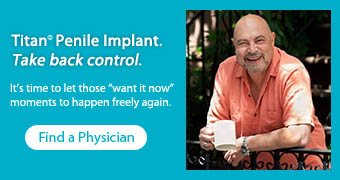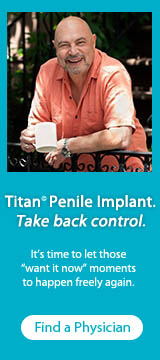I agree Tomas.....it seems like “best practice” should be settled by this time about leaving inflated immediately post op or not.
I know scar tissue forms at different rates, (time) for everyone, but on a bell curve a certain number are early responders the big portion (the bell) are the average, the other end is late responders. It’s really confusing why some docs do and some don’t. Of course they can persuade the patient with convincing arguments on both!
I just finished my pre op eval. My doc does not leave inflated post op.....so I’ll know soon enough how the scar tissue formation works for me!
Which Surgeons Keep Implant Inflated Post Op
Re: Which Surgeons Keep Implant Inflated Post Op
Diagnosed venous leak. Going with injections rather than implant for the time being.
Re: Which Surgeons Keep Implant Inflated Post Op
Yes, I think that's the case. Here's an old post where Dr Eid explains his protocol. See the last part "Post-operative care".tomas1 wrote:I wonder if there may be a trade off to prevent scar tissue around cylinders or reservoir?
strongagain wrote:VERY INFORMATIVE:
"Patient’s need to be aware of key issues that determine the penile length, feel of the cylinders, quality of erection and cosmetic appearance of the penis after the penile implant procedure. First a penile implant has limitations and although satisfaction rates are extremely high, an inflatable penile implant will not function exactly like a “normal” penis. The
flaccid penis with an implant cannot retract like a “normal” penis. The flaccid penis therefore will always be longer than before the implant was inserted.
Second, when the cylinders are deflated, the flesh of the penis will no longer be under tension and will retract causing the deflated cylinders to bend and fold inside the
shaft of the penis like an accordion. The folds will be more prominent and palpable with the Coloplast Titan than with the AMS cylinders. In a beefy overweight patient with the
metabolic syndrome for example, this will not be an issue, but in a very thin frail elderly patient this may be uncomfortable and unsightly. In general the deflated AMS
cylinders are more comfortable and softer than the deflated Coloplast cylinders.
Third, to date nothing exists in the world to make the erect penis longer (including vacuum devices, traction or surgery). And neither the Coloplast nor the AMS LGX will
increase the length of the erect penis. At best the length of the erect penis with the implant will be the same as the length of the erect penis measured before the implant
procedure in the standing position after a penile injection test.
Finally the health of the tunica albuginea (the thick layer that surrounds the erectile muscle) also will impact the size of the implanted penis, as does the postoperative
care, which I will discuss later. In a patient with vascular disease or diabetes the tunica may be thickened and loses its elasticity limiting its ability to stretch. This may decrease the overall length of the pre-implanted erect penis. So does Peyronie's disease, which in a patient with ED may not be revealed until the patient is in the OR.
Choice of implant cylinder
The AMS cylinders are tunical independent and will only expand to 18mm girth (a mesh prevents further expansion). This is more than adequate for many patients.
For patients requiring cylinder length of 20cm or more this lateral expansion may not be enough and better rigidity will occur with the wider Coloplast cylinders (the longer
cylinders expand to 21mm plus). The Coloplast cylinders are tunical dependent and if the tunica is not healthy or thin, the rigidity will not be as good as with the AMS
cylinders. The Coloplast cylinders expand fully against the tunica and overtime this can cause thinning and atrophy the tunica albuginea which will cause the penis to become very wide and less rigid. On the other hand, use of the AMS cylinders in the larger and wider penises will cause inadequate rigidity of the penis as well as a flat appearance of the shaft
of the erect penis. The urethra, which is usually at the bottom of the shaft, will instead nestle between the narrower AMS cylinders. It's important to have all types, makes and sizes of cylinders for every case, because often the surgeon may not have pre-operative knowledge of all the variables necessary to select the best cylinder option for that particular individual. For practical reasons, most urologists will use the same brand of penile implant for every patient.
The issue of rear tips extenders
The inflatable cylinder is made of a non-inflatable rear portion that measures 4.5cm (AMS) and 5 cm (Coloplast) and an inflatable anterior portion of variable length. So for
example a 20cm Coloplast cylinder will only have 15cm of inflatable distal portion. The fixed proximal portion also has a thinner diameter. For the AMS cylinders that diameter
is only 9mm. Often surgeons will increase the length of the proximal portion with rear tip extenders to adjust the size of the cylinders, rather than choosing a cylinder of the correct
length. For example if a patient measures 20cm and the doctor is committed in using an AMS device he will have to use an 18cm with 2cm rear tip extenders. Therefore only
13.5cm out of the total 20cm inflates; the rear, which now measures 6.5cm, is thin and non-inflatable. The unstable junction where the inflatable portion connects with the
fixed rear portion will now be located in a more distal position in the penile shaft and the erection will have a hinge effect, wobble and point downward when the cylinders are inflated. This may not affect the overall length of the penis but will decrease the quality of the erection. Instead a better choice would have been to use a 20cm
Coloplast (AMS does not make a 20cm). Most urologists, including yours truly, were trained believing that the crus of the penis does not play a significant role on the quality of
the erection and that placing a thin non-inflatable implant would not affect the outcome. Use of rear tip extenders decreases the quality of the erection.
Post-operative care
During the first three months after the surgery the cylinders must be kept fully deflated in order to maintain the reservoir fully inflated. This will allow scar tissue to form on a full reservoir and prevent auto-inflation later on. This means that the penis will heal over deflated cylinders and scar tissue will form over cylinder folds and curvatures.
A long wide penis with deflated cylinders may retract by as much as two inches. If the implant is not inflated early in the immediate two weeks after the surgery, it may heal in
this foreshortened dimension, causing permanent deformity and reduced inflated length. In order to be able to inflate early one must be able to feel all of the components of the
pump, inflating bulb and deflation footprint. The more experienced the surgeon and the more precise the surgical technique the less swelling and pain will occur after the
surgery. Incisions and dissection must be kept at a minimum and meticulous surgical hemostasis must be achieved so that the patient's postoperative risk of hematoma and swelling is reduced. This will enable the patient to feel the components of the pump early after the procedure and inflate and deflate as soon as possible. Think of it as rehab after an orthopedic procedure. If the shoulder is kept in a sling for several postoperative weeks, the shoulder will freeze in that position. Post-op bed rest for 48 hours with ice followed by daily hot baths will minimize swelling and accelerate healing. Unfortunately in most general urology practices post-operative care is often relegated to ancillary staff with little knowledge of these issues. It is vital, especially for the larger stretchy penises that inflation and deflation of the cylinders is started as soon as possible in order to prevent healing in a retracted foreshortened state. Maximizing length and quality of the erection as well as cosmetic appearance depends on many factors perhaps
the most important being the practice implant volume and surgeon's experience."
by Dr. Francois Eid
Implant - Dr Eid 12/2017, Titan Touch 20/21cm no RTE, 125cc reservoir
-
Larry10625
Re: Which Surgeons Keep Implant Inflated Post Op
warrenw wrote:Yes, I think that's the case. Here's an old post where Dr Eid explains his protocol. See the last part "Post-operative care".tomas1 wrote:I wonder if there may be a trade off to prevent scar tissue around cylinders or reservoir?strongagain wrote:VERY INFORMATIVE:
"Patient’s need to be aware of key issues that determine the penile length, feel of the cylinders, quality of erection and cosmetic appearance of the penis after the penile implant procedure. First a penile implant has limitations and although satisfaction rates are extremely high, an inflatable penile implant will not function exactly like a “normal” penis. The
flaccid penis with an implant cannot retract like a “normal” penis. The flaccid penis therefore will always be longer than before the implant was inserted.
Second, when the cylinders are deflated, the flesh of the penis will no longer be under tension and will retract causing the deflated cylinders to bend and fold inside the
shaft of the penis like an accordion. The folds will be more prominent and palpable with the Coloplast Titan than with the AMS cylinders. In a beefy overweight patient with the
metabolic syndrome for example, this will not be an issue, but in a very thin frail elderly patient this may be uncomfortable and unsightly. In general the deflated AMS
cylinders are more comfortable and softer than the deflated Coloplast cylinders.
Third, to date nothing exists in the world to make the erect penis longer (including vacuum devices, traction or surgery). And neither the Coloplast nor the AMS LGX will
increase the length of the erect penis. At best the length of the erect penis with the implant will be the same as the length of the erect penis measured before the implant
procedure in the standing position after a penile injection test.
Finally the health of the tunica albuginea (the thick layer that surrounds the erectile muscle) also will impact the size of the implanted penis, as does the postoperative
care, which I will discuss later. In a patient with vascular disease or diabetes the tunica may be thickened and loses its elasticity limiting its ability to stretch. This may decrease the overall length of the pre-implanted erect penis. So does Peyronie's disease, which in a patient with ED may not be revealed until the patient is in the OR.
Choice of implant cylinder
The AMS cylinders are tunical independent and will only expand to 18mm girth (a mesh prevents further expansion). This is more than adequate for many patients.
For patients requiring cylinder length of 20cm or more this lateral expansion may not be enough and better rigidity will occur with the wider Coloplast cylinders (the longer
cylinders expand to 21mm plus). The Coloplast cylinders are tunical dependent and if the tunica is not healthy or thin, the rigidity will not be as good as with the AMS
cylinders. The Coloplast cylinders expand fully against the tunica and overtime this can cause thinning and atrophy the tunica albuginea which will cause the penis to become very wide and less rigid. On the other hand, use of the AMS cylinders in the larger and wider penises will cause inadequate rigidity of the penis as well as a flat appearance of the shaft
of the erect penis. The urethra, which is usually at the bottom of the shaft, will instead nestle between the narrower AMS cylinders. It's important to have all types, makes and sizes of cylinders for every case, because often the surgeon may not have pre-operative knowledge of all the variables necessary to select the best cylinder option for that particular individual. For practical reasons, most urologists will use the same brand of penile implant for every patient.
The issue of rear tips extenders
The inflatable cylinder is made of a non-inflatable rear portion that measures 4.5cm (AMS) and 5 cm (Coloplast) and an inflatable anterior portion of variable length. So for
example a 20cm Coloplast cylinder will only have 15cm of inflatable distal portion. The fixed proximal portion also has a thinner diameter. For the AMS cylinders that diameter
is only 9mm. Often surgeons will increase the length of the proximal portion with rear tip extenders to adjust the size of the cylinders, rather than choosing a cylinder of the correct
length. For example if a patient measures 20cm and the doctor is committed in using an AMS device he will have to use an 18cm with 2cm rear tip extenders. Therefore only
13.5cm out of the total 20cm inflates; the rear, which now measures 6.5cm, is thin and non-inflatable. The unstable junction where the inflatable portion connects with the
fixed rear portion will now be located in a more distal position in the penile shaft and the erection will have a hinge effect, wobble and point downward when the cylinders are inflated. This may not affect the overall length of the penis but will decrease the quality of the erection. Instead a better choice would have been to use a 20cm
Coloplast (AMS does not make a 20cm). Most urologists, including yours truly, were trained believing that the crus of the penis does not play a significant role on the quality of
the erection and that placing a thin non-inflatable implant would not affect the outcome. Use of rear tip extenders decreases the quality of the erection.
Post-operative care
During the first three months after the surgery the cylinders must be kept fully deflated in order to maintain the reservoir fully inflated. This will allow scar tissue to form on a full reservoir and prevent auto-inflation later on. This means that the penis will heal over deflated cylinders and scar tissue will form over cylinder folds and curvatures.
A long wide penis with deflated cylinders may retract by as much as two inches. If the implant is not inflated early in the immediate two weeks after the surgery, it may heal in
this foreshortened dimension, causing permanent deformity and reduced inflated length. In order to be able to inflate early one must be able to feel all of the components of the
pump, inflating bulb and deflation footprint. The more experienced the surgeon and the more precise the surgical technique the less swelling and pain will occur after the
surgery. Incisions and dissection must be kept at a minimum and meticulous surgical hemostasis must be achieved so that the patient's postoperative risk of hematoma and swelling is reduced. This will enable the patient to feel the components of the pump early after the procedure and inflate and deflate as soon as possible. Think of it as rehab after an orthopedic procedure. If the shoulder is kept in a sling for several postoperative weeks, the shoulder will freeze in that position. Post-op bed rest for 48 hours with ice followed by daily hot baths will minimize swelling and accelerate healing. Unfortunately in most general urology practices post-operative care is often relegated to ancillary staff with little knowledge of these issues. It is vital, especially for the larger stretchy penises that inflation and deflation of the cylinders is started as soon as possible in order to prevent healing in a retracted foreshortened state. Maximizing length and quality of the erection as well as cosmetic appearance depends on many factors perhaps
the most important being the practice implant volume and surgeon's experience."
by Dr. Francois Eid
Really???
So, which is it...
"This will enable the patient to feel the components of the pump early after the procedure and inflate and deflate as soon as possible."
or
"During the first three months after the surgery the cylinders must be kept fully deflated in order to maintain the reservoir fully inflated."
Everybody needs to proof read what they dictate before pressing the "POST" button.
Larry
-
Lost Sheep
- Posts: 6144
- Joined: Mon Jul 04, 2016 11:16 pm
Re: Which Surgeons Keep Implant Inflated Post Op
Larry10625 wrote:
Really???
So, which is it...
"This will enable the patient to feel the components of the pump early after the procedure and inflate and deflate as soon as possible."
or
"During the first three months after the surgery the cylinders must be kept fully deflated in order to maintain the reservoir fully inflated."
Everybody needs to proof read what they dictate before pressing the "POST" button.
Larry
Both. The apparent contradiction is resolved by understanding the difference (it makes to the growth of encapsulating scar tissue) between "kept fully deflated" and "inflate and deflate".
Maintaining the reservoir fully inflated does not preclude short periods of inflation of the implant on a regular schedule because it takes time for scar tissue to encapsulate the implants (reservoir and inflatable tubes).
The difference is that the tubes can be forcefully inflated to break up that scar tissue as it is forming. Doing this on a regular schedule, the discomfort/pain is minimized to a manageable level. The breaking up of the encapsulation around the tubes is thus possible. Breaking up the encapsulation around the reservoir is not practical, because there is no way to forcefully pump up the reservoir. Also, the forceful inflation of the reservoir is not controlled by the shape of body tissues (as the tunica albuginea does for the tubes) or the material of that part of the device (as the inflatable tubes are), so getting a misshapen reservoir would be problematic.
Lost Sheep
AMS LGX 18+3 Nov 6, 2017
Prostate Cancer 2023
READ OLD THREADS-ask better questions -better understand answers
Be part of your medical team
Document pre-op size-photos and written records
Pre-op VED therapy helps. Post-op is another matter
AMS LGX 18+3 Nov 6, 2017
Prostate Cancer 2023
READ OLD THREADS-ask better questions -better understand answers
Be part of your medical team
Document pre-op size-photos and written records
Pre-op VED therapy helps. Post-op is another matter
Re: Which Surgeons Keep Implant Inflated Post Op
Yeah, I'm sure regular cycling is very important early on more so than keeping it one way or the other.
On a side note I really appreciate all the knowledge imparted on this site and this subject.
Without it, I would really be on my own since my surgeon left me on my own.
I do know he knows I've done my research though.
Maybe that's why he didn't give me ANY post-op instructions except "see me in 2 weeks".
On a side note I really appreciate all the knowledge imparted on this site and this subject.
Without it, I would really be on my own since my surgeon left me on my own.
I do know he knows I've done my research though.
Maybe that's why he didn't give me ANY post-op instructions except "see me in 2 weeks".
85 years
Inject testosterone weekly.
Implant on 1/22/19 by Dr Avila.
Scrotal, hor. incision just over 1"
18cm AMS 700 CX, 3.5cm RTE 100cc res
Gleason 6 prostate cancer. Monitoring it for now.
Update: On my last biopsies the cancer wasn't found.
Inject testosterone weekly.
Implant on 1/22/19 by Dr Avila.
Scrotal, hor. incision just over 1"
18cm AMS 700 CX, 3.5cm RTE 100cc res
Gleason 6 prostate cancer. Monitoring it for now.
Update: On my last biopsies the cancer wasn't found.
Re: Which Surgeons Keep Implant Inflated Post Op
I'm sure Eid knows what he meant but it would have been better for it to have been proofed before he posted it. Kept fully deflated should have been followed by except for brief cycling.
I've asked Dr Kramer to finish dilating my right side so if he does I'll have more pain than a usual revision. And I will inflate deflate regularly starting day 3 or 4. I'm excited to FINALLY get this thing right. Counting the days till June.
I've asked Dr Kramer to finish dilating my right side so if he does I'll have more pain than a usual revision. And I will inflate deflate regularly starting day 3 or 4. I'm excited to FINALLY get this thing right. Counting the days till June.
LGX 18cm+3cmRTE 8 / 8/18 by Docs Saracino , Prody of FL Disfigured by Implant. Married 31 years, Functionally impotent 2+ years. 4" day of surgery now 7" inflated after VED 6.5" without. Pump moved 12/4/18 by Dr Kata
-
GruffHunter
- Posts: 112
- Joined: Sun Sep 23, 2018 10:43 pm
- Location: Chester, VT, USA
- Contact:
Re: Which Surgeons Keep Implant Inflated Post Op
And it should be noted that while Dr Eid is a Giant in this field...some doctors that have trained regularly directly under his tutelage, and have a high degree of respect for him... have come to disagree with his protocol here.
Gruff Hunter, 59, Titan (24 cm + 1 inch extenders) implanted by Dr Gross, 07 Jan 2017. Gay/open marriage, Chester, VT, USA
-
dirtman1993
- Posts: 519
- Joined: Thu Feb 05, 2015 4:12 pm
- Location: Beech Mountain
Re: Which Surgeons Keep Implant Inflated Post Op
After reading all this, glad I selected Dr. Kramer and there were other reasons. I studied a lot here before selecting and believe I was correct in doing so. I have had ZERO problems, had some extra work done on the lower left side due to internal scaring he found and had to wait over 30 days before inflating due to internal swelling. Only know this as I went back for my first inflate where Dr. Kramer saw and felt what was going on. Suggested I wait another week or two which I did and had no problem.
Had some boring like after lifting weight and the muscle burn you get. That stopped and he mentioned he left me about 20 to 30% inflated after surgery. Been two years and if I ever have a problem and need a revision, I will see Dr. Kramer again and be thankful for his help and direction.
Always search for the doctor you have faith in and then read more. Good luck to all.
Had some boring like after lifting weight and the muscle burn you get. That stopped and he mentioned he left me about 20 to 30% inflated after surgery. Been two years and if I ever have a problem and need a revision, I will see Dr. Kramer again and be thankful for his help and direction.
Always search for the doctor you have faith in and then read more. Good luck to all.
Implanted March 2nd by Dr. Kramer with AMS/LGX. Had a problem lower left (scar tissue) and he placed a larger (thicker) implant as you can here on the YouTube video. Got all back, ED over 10 years before Implant.
Who is online
Users browsing this forum: Google [Bot] and 120 guests






